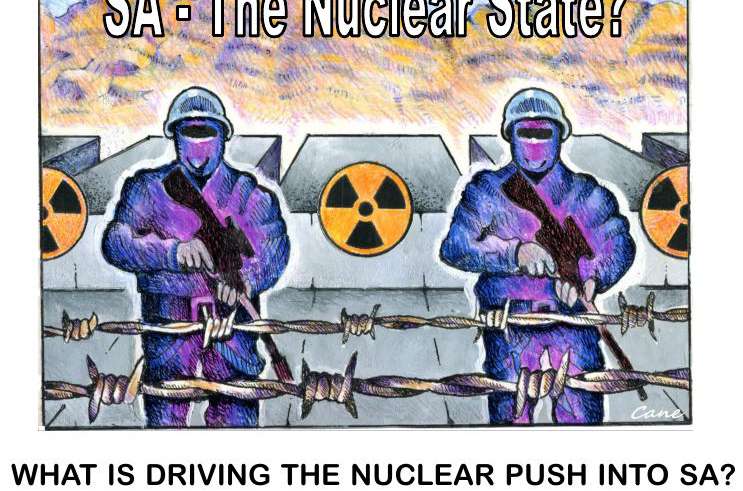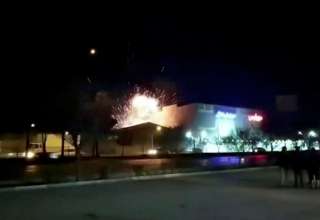Talk by David Palmer at “SA – The Nuclear State” forum
April 23, 2017 – Adelaide, South Australia
 South Australians won a major victory when the Citizens Jury overwhelmingly rejected the Royal Commissions recommendation for an international nuclear waste dump in the state. State Premier Wetherill lost the backing of the Opposition in parliament and was forced to withdraw his proposal. Voters did not like the plan and it appeared that the Labor State Government had pulled back. But a new story is emerging. This fight has actually moved to new level. Major corporate, government, and military stakeholders have continued pressuring for reconsideration. These are powerful interests that have long had financial interests in a larger project – one that I’d like to briefly outline.
South Australians won a major victory when the Citizens Jury overwhelmingly rejected the Royal Commissions recommendation for an international nuclear waste dump in the state. State Premier Wetherill lost the backing of the Opposition in parliament and was forced to withdraw his proposal. Voters did not like the plan and it appeared that the Labor State Government had pulled back. But a new story is emerging. This fight has actually moved to new level. Major corporate, government, and military stakeholders have continued pressuring for reconsideration. These are powerful interests that have long had financial interests in a larger project – one that I’d like to briefly outline.
There are other speakers and participants here today who have more expertise in the scientific and engineering details of this controversy than I do. My comments are aimed, instead, at those powerful elite stakeholders who are at the core of what we know as the military-industrial complex – here in South Australia, our country, but also globally, with its centre in the United States.
Is this issue of a nuclear waste dump advocated for South Australia just about jobs and economic prosperity, as Premier Wetherill claims? Or is it far broader? The words of Ben Heard, former executive director of pro-nuclear power lobby group Bright New World, sum it up well: “We must be a full service provider to the nuclear back-end.”[1] Adelaide’s Advertiser reported last month that “a new open letter [has been sent] to state MPs, 42 influential people demand[ing] the State Government commits to completing first-stage investigations of the proposed high-level repository.”[2] Many of these “influential people” signed a similar letter back in December demanding the same thing, through Ben Heard’s pro-nuclear Bright New World.
But just what is this “nuclear back-end” – the back end of what? Nuclear materials have a wide range of uses, including medical and commercial ones that are distinct from their main uses for power generation and weapons. The vast majority of government expenditures related to nuclear materials goes toward nuclear weapons and military uses (such as naval propulsion systems), and nuclear power. In the United States, virtually all nuclear-related industries and products in the energy and military-application areas are joint operations involving private companies working under government contracts and regulations. The scientific and engineering knowledge required for the nuclear industry means that universities and university-linked research centres play a major role in bringing these two institutions – private companies and government – together. In South Australia, Ben Heard (who is connected to University of Adelaide) is symbolic of this key link connecting networked institutions and elites.
The precedent for this corporate-government-military-university linkage began with the Manhattan Project of World War II, the massive project that led to the development of the first three atomic bombs: Little Boy (the uranium core Hiroshima bomb), and Trinity (the New Mexico test bomb) and Fat Man (the Nagasaki bomb) that both had plutonium cores. The most important leaders of the Manhattan Project were General Leslie Groves (U.S. Army Corps of Engineers) and J. Robert Oppenheimer (theoretical physicist and professor of physics at University of California Berkeley). The bomb was developed in large part developed at Los Alamos Laboratory in New Mexico, but the plutonium core required its own facility at Hanford, in Washington state where over 50,000 workers were hired by DuPont chemical corporation to run the operation. DuPont also was contracted to build the sprauling complex.
Following the end of World War II, the US built hydrogen bombs far beyond the destructive capacity of the Hiroshima and Nagasaki atomic bombs. At the same time, work began on developing nuclear power for supposedly peaceful purposes, what President Eisenhower dubbed the “Atoms for Peace” program – now generally recognized as integral to Cold War propaganda. There’s no denying that nuclear power became a major part of domestic electrical power generation. But the link between nuclear power development and nuclear weapons development continues to the present, even though international use of nuclear power plants for civilian energy use continues. However, the bigger picture is the linkage of these two – via the military-industrial complex that Eisenhower warned about in his famous Farewell Address of 1961.
Let’s just back up for a moment and ask a question – the one related to “experts” versus “non-experts”. Why do I have any right to talk here today about such a complex issue as nuclear energy, nuclear waste, and the linkage to nuclear weapons? I am just an academic trained in history, including economic, political, and social history. But I do not have a degree or any direct experience in nuclear physics or nuclear applications. I have interviewed many atomic bomb survivors from Hiroshima and Nagasaki over the last two decades, so I’ve heard and seen the physical and psychological consequences of what atomic bombs do to people’s lives and health. But I am not an expert on the medical assessment of radiation on the human body. So what gives me the right to speak to you here today?
The answer, I believe, is that ordinary citizens, ordinary but intelligent people, have a right to speak on these issues – and in places like Fukushima, Japan they have taken this right to a new level. Women, particularly mothers concerned for the welfare of their children, urgently want an end to nuclear power in Japan and full disclosure of all the information related to the Fukushima nuclear disaster, including accurate medical and radiation level information. They are organised and call themselves “Citizen Scientists.” They study the basics of nuclear technology and its applications to better challenge the industry, the corporate cover-ups by TEPCO, and the deceptions promoted by the Abe LDP government in power. They study the medical science behind radiation illness and convey this knowledge to others. This “citizen science” knowledge is their empowerment that defies the state and the corporations that have lied to them and endangered their lives and those of their family and neighbors.
These women defy the illusion that you have to have a Ph.D. in nuclear physics or in nuclear engineering – that you must be a Ben Heard – to have a legitimate voice about nuclear power and the potential dangers of nuclear industry accidents. Our movement needs scientific experts, but all of us can gain basic knowledge and speak out.
If citizens – the people – whether they are in the Fukushima region of Japan or in Adelaide, South Australia – have a right to speak out on the dangers of the nuclear industry, then who are the elites promoting the nuclear industry? If we look at prominent figures in government the institutional linkages become all too clear. Consider the example of Kevin Scarce, Governor of South Australia until 2014, a Rear Admiral retired from the Royal Australian Navy, current Chancellor of the University of Adelaide, and Deputy Chairman of Seeley International, the largest air conditioning company in Australia that is known for energy-efficiency. Scarce led the Nuclear Fuel Cycle Royal Commission and was the primary author of the report that recommended the South Australian government accept a nuclear waste dump. All the links are there in Scarce’s connections and positions: military, university, corporate, and government.
Furthermore, the Royal Commission did not focus solely on a nuclear waste dump. It considered possible expansion of nuclear industries in the state that encompassed mining, enrichment, and power generation. The Royal Commission report states that “The activity under consideration is the further processing of minerals, and the processing and manufacturing of materials containing radioactive and nuclear substances (but not for, or from, military uses) including conversion, enrichment, fabrication or reprocessing in South Australia.”[3]
But during the time this Royal Commission report was being prepared and finally delivered, Adelaide became the focal point for naval shipbuilding contracts, particularly submarines. Both Labor and Liberal politicians sought to outdo each other in pushing for submarines to be built in Adelaide. They will be diesel powered, but the majority of submarines internationally use nuclear power propulsion. Potential overseas contractors also use designs geared for nuclear power. There are those in Australian naval circles who would like to see these Australian subs with nuclear, not diesel, power. And where will these submarines be used, and with what international interests? We know the answer to that question, as recent events in the Western Pacific have confirmed. The USS Carl Vinson, the nuclear powered air craft carrier, was on exercises in the Indian Ocean in early April with Australia’s HMAS Ballarat, when it was ordered to the Korean peninsula this month in response to the North Korean threat to explode a nuclear bomb.[4] This latest development is just one example of the escalating naval tensions on our side of the Pacific. Crises like this will potentially increase pressure for Australia to build submarines – and possibly other naval vessels – that are nuclear powered.
What does the corporate profile of the “nuclear industry” look like? Consider this list from the 2015 “Top 100 Global Defense Companies.”[5] Of 100 listed, 41 are based in the United States. Seven of the top ten are American: Lockheed Martin, Boeing, Raytheon, General Dynamics, Northrup Grumman, United Technologies, and L-3 Communications. Five of these seven corporations in the top ten have products related to nuclear military technology or applications, such as guidance systems and missiles for warheads. United Technologies and L-3 Communications have divisions related to civilian nuclear power, beyond their military contracts. All these seven corporation have operations in Australia, and five have operations in South Australia (Raytheon, United Technologies, Boeing, General Dynamics, and Lockheed Martin). I’ve only considered the top seven US companies in the top ten of this list. Further investigation into other companies on this list, US and international, will tell us more.
South Australia Premier Wetherill’s rationale for the nuclear waste dump obviously is related to the mining industry in the state. The Royal Commission report called for “the expansion of the current level of exploration, extraction and milling of minerals containing
radioactive materials in South Australia,”[6] as well as a reduction in regulations over the mining industry. In this section of the report there is great detail on safety measures to be undertaken and environmental impact concerns, but the scope of this overall plan – from mining, to energy production, to waste storage – creates an entirely new level of South Australia’s dependence on the nuclear industry. Contrary to past Labor Party policy, particularly under former Prime Minister Gough Whitlam, Premier Wetherill backed an expansion of uranium mining, using the Royal Commission’s recommendation as the basis for his advocacy. He dropped his proposal for the nuclear dump when the Liberal Party opposition refused to support it.[7] The Greens, of course, have criticised the entire scope of the initiative. In his earlier visit to Finland to inspect that country’s advanced nuclear waste storage operation at Okalo, near the town of Eurajoki, Wetherill emphasized that South Australia had 25 per cent of the world’s uranium reserves. But when he met with Eurajoki Municipal Council president Vesa Jalonen near the Okalo site, Jalonen rejected Wetherill’s “moral argument” that South Australia should accept nuclear waste as a responsibility to the over 400 nuclear plants around the world that have used uranium from South Australian mines. According to The Australian, “Mr Jalonen said the local economy had benefited from the nuclear industry after moving away from agriculture, but [added] … ‘[i]t is impossible to say what is right, but I think you don’t have to think in that (moral) way about taking responsibility for uranium … ‘Of course there are big questions of the (economic) benefits you can get.’”[8] Jalonen’s comment exposed Premier Wetherill’s evasion of his real motives: economic, not ‘morality.’ The Okalo site, deep underground, is the most advanced nuclear waste storage facility in the world, and it is technologically far superior to what was proposed for South Australia. It also is only a tenth of the size of the operation pushed by South Australian nuclear waste storage advocates. The Finnish site does not accept any waste except from Finnish sources. The South Australian facility would accept international waste, far beyond realistic capacity.
Mining clearly is driving much of this nuclear waste dump agenda. BHP Billiton, the world’s largest mining corporation, operates Olympic Dam Mine in Roxby Downs, which holds the largest deposit of uranium in the world but currently only has 25 percent of its mining there based on uranium. The demand for building new nuclear power plants has decreased dramatically since the Fukushima nuclear power plant disaster of 2011. China stopped all new nuclear power plant construction after the 2011 Fukushima disaster; Japan shut its reactors, with only one up again as of April 2017; and ratings agencies such as Standard and Poors have substantially cut credit ratings of energy companies that concentrate on nuclear power.
Nevertheless, other uses, particularly related to military applications, have increased. With a nuclear waste dump in South Australia that accepts international shipments, the full range of the “nuclear industry” in the state would be complete, truly making it the “Defense State” that has become the state motto.[9]
But is this really the direction that South Australian – and Australians nationally – want their economy and their society to take? Is it consistent with, or a violation of, Aboriginal land rights and respect for the land? How dependent have we become on corporations that rely on military contracts and ties to US military interests? What role will the “nuclear industry cycle” play in this process? What are the dangers for us not just from potential radiation from a nuclear waste dump, but also from the broader possibilities of an expanding nuclear-based military-industrial complex in South Australia – and across Australia?
The debate about a South Australian nuclear waste dump needs to consider these broader ramifications. At the same time, refusing to agree to an international nuclear waste dump in South Australia is a crucial initial step toward turning away from the nuclear military-industrial complex toward a better, more productive economy and a safer environment for all.
[1] Ben Heard, Nov. 2, 2016. https://decarbonisesa.com/2016/11/02/we-must-be-a-full-service-provider-to-the-nuclear-back-end/ (accessed 21 April, 2017) [2] “New Push for high-level international nuclear waste dump in South Australia,” The Advertiser, 2 March, 2017 http://www.adelaidenow.com.au/news/south-australia/new-push-for-highlevel-international-nuclear-waste-dump-in-south-australia/news-story/fcc16323dfc87c46d83dc358f8c7f59a (accessed 21 April, 2017) [3] Nuclear Fuel Cycle Royal Commission Report – May 2016, p. 29. https://nuclear.yoursay.sa.gov.au/system/NFCRC_Final_Report_Web.pdf (accessed 21 April, 2017) [4] http://www.abc.net.au/news/2017-04-18/china-has-to-take-action-against-north-korea-turnbull-says/8451512 (accessed 21 April, 2017) [5] “Defense News Top 100 Defense Companies (2015) https://www.artillerymarketing.com/fs/defense-news-top-100-global-companies-2015 (accessed 4 April, 2017) Data on individual companies is from corporate websites of company listings on this site. [6] Royal Commission Report, p. 9. [7] http://www.adelaidenow.com.au/news/south-australia/premier-jay-weatherill-backs-expansion-of-uranium-mining-in-south-australia/news-story/28cc5b147ce446430ad812a5105f7662 (accessed 4 April, 2017) [8] http://www.dailytelegraph.com.au/news/warm-inner-glow-sas-nuke-future/news-story/a5b4818966684de1482ad74bcfe46200; http://www.theaustralian.com.au/business/sa-premier-weatherills-nuclear-moral-case-rejected/news-story/c4849e0b93715dbdecbef1057285c946 (accessed 4 April, 2017) [9] http://www.defencesa.com/ (accessed 4 April, 2017)




